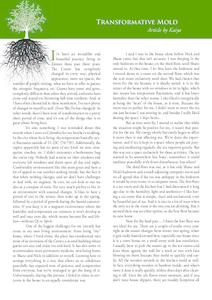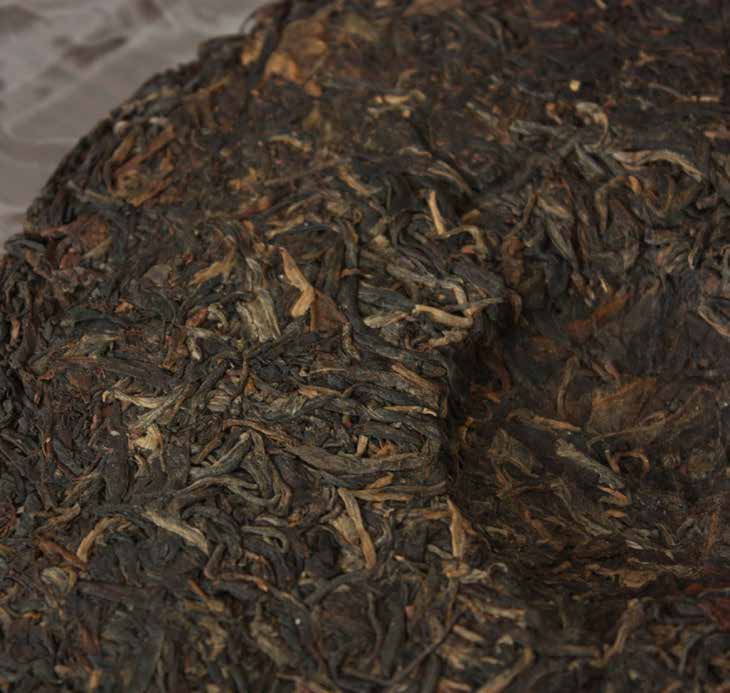
 |
|
It's been an incredible and beautiful journey, living in Taiwan these past three years. The Center has completely changed in every way: physical appearance, more tea spaces, the number of people visiting, what we have to offer to guests, the energetic frequency, etc. Guests have come and gone, completely different than when they arrived, and some have come and stayed on, becoming full-time residents. And, as I have often chronicled in these newsletters, I've seen plenty of changes in myself as well. (Even Wu De has changed). In other words, there's been tons of transformation in a pretty short period of time, and it's one of the things that is so great about living here.

It's also something I was reminded about this month when I went to Colombia for my brother's wedding. In the city where he is living, the temperature basically never fluctuates outside of 21-23C (70-75F). Additionally, the region apparently has no pests of any kind: no ants, mosquitos, roaches, etc. I didn't encounter a bothersome bug the entire trip. Nobody had screens on their windows and everyone left windows and doors open all day and night. Comfortable environments like this seem great and have a lot of appeal to our comfort-seeking minds, but the fact is that when nothing changes, and we don't have challenges to deal with, we stagnate. As ever, we can look to our tea also as a compass of sorts. Tea very much prefers to live in an environment with seasonal changes. It likes to have a period of rest in the winter, then wake up in the spring, followed by a period of growth during the humid summertime. If you keep it in a stagnant environment where the humidity and temperature are constant, it won't develop as well and may even die, which means become flat and lifeless - without Qi or Spirit.
One of the biggest challenges for me recently has come in my own living environment: From being "my" house, where I lived alone, the place has transformed into more of an extension of the Center, a second building where guests can stay and enjoy tea and food. It has also come to accommodate more permanent residents, now being home to Shane and Nick in addition to myself. Learning how to arrange everything in a way that allows us to cohabitate peacefully has required tons of patience and compromise from everyone, but we've managed to get the hang of it. Unfortunately, during this process, I failed to relate to everyone in the house in an equally considerate way.
I said I was in the house alone before Nick and Shane came, but that isn't accurate. I was sleeping in the only bedroom in the house, on the third floor, until Shane moved in. At that time, I let him have the bedroom and I moved down to a room on the second floor, which was the tea's room exclusively until then. We had chosen that room for the tea because it is ideally suited: it is in the center of the house with no windows to let in light, which also means less temperature fluctuation, and it has lower humidity than the other rooms. I also liked it energetically as being the 'heart' of the house, as it were. Because the room was so perfect for tea, I didn't want to move the tea out just because I was moving in, and besides I really liked sharing the space. I slept better.
But as time went by, I started to realize that while the situation might be positive for me, it wasn't that positive for the tea. My energy slowly but surely began to affect it more than it was affecting me. We've done the experiments, and if tea is kept in a space where people are praying and meditating regularly, the tea improves greatly. But this was not a space exclusively for those activities. The tea wanted to be somewhere less 'busy', somewhere it could meditate peacefully with fewer disturbances, but where?
The third floor was out, as it has only Shane and Nick's bedroom and a small adjoining computer room and we all agreed that if the tea was unhappy in the bedroom it would be even worse in a computer room. The first floor is a tea room and the kitchen but I had discounted it long ago due to the humidity, light and aesthetics - I like having a tea room that is simple, clean and uncluttered, even by beautiful jars of tea. And it is nice in a lot of ways when the only tea in the room is the one you are drinking. But it seemed there was no other option, so the first floor became its new home.
Now for the hard part... I knew the first floor was not ideal for tea. There are a couple of weeks every year, right as the season changes from winter into spring, when it gets really humid around here, especially our house since it is a town house on a small street with less ventilation. I usually have to pick the tatami up in the tea rooms and leave them against the wall for a week or two with fans blowing on them because they mold so quickly and easily. All the wooden utensils in the kitchen mold as well. In fact, everything wooden or bamboo molds, and what's more it does it really quickly, within three days after cleaning it off. Even the tile floors sweat moisture, and if you don't wear house slippers, there are muddy footprints all over the house in no time, no matter how careful you try to be.
I knew all this, and still I didn't really take enough care and consideration for the tea. I checked for external signs of mold in the house - the tatami, the wood on the shelves, and so on. Not seeing any, I didn't bother checking the tea itself, thinking that these external things would mold more easily than tea inside of jars, wrapped in paper and cardboard. We drink tea every morning at the center, so we very rarely drink tea at home, and it's not unusual to go a week or two between sessions there. But that's not a good excuse, and again it betrayed an unhealthy attitude on my part. I was treating my tea as though drinking it was the only relationship I recognized or valued; like a friend that never calls you unless they want something from you, which obviously is not a friend at all.

And yet, my consternation could not easily be exaggerated when I finally opened one of my favorite Puerh cakes for a session one morning and beheld that it was covered with little white spores. My face fell. My heart sank. Frankly, I cried. I felt such remorse, such despair. I immediately saw the error of my ways. I felt like a father might feel who had been too busy with work for all those years and one day opened his eyes and discovered his son had turned into a rotten apple. I had failed my tea, neglected it. I had allowed it, and most importantly my relationship with it, to stagnate.
Opening cake after cake, jar after jar, I discovered that the damage was extensive, indeed. With the exception of my glazed, tightly sealed jars of Oolongs and Yanchas, as well as some of the really old Puerh, everything had been affected. The mold was white, and had a bad smell. I tried brewing some of the least-affected tea I could find, and it was terrible. The tea was all lost. I had killed it through my inconsideration and lack of concern after putting it somewhere I knew would be uncomfortable and potentially dangerous for it to live. For at least a whole 24 hours, I was absolutely not in a state of acceptance of this fact. This transformation was too uncomfortable; I didn't want to go through it, didn't want to believe in it, as evidenced by the recurring thoughts along the lines of "I can't believe I..."
One of the hard realizations that came along with this situation, of course, was the necessity of telling Wu De. He scolds me all the time for not listening to all kinds of things, from cups to computers. But to admit to not listening to the tea in my house, and to such a great extent, was not something I looked forward to at all. But I had to know if there was anything I could do, how to "apologize" as it were. I couldn't waste any more time, knowingly leaving the tea in discomfort and stagnation, no matter how uncomfortable telling Wu De about it was going to be. The foremost thought in my mind was that I wanted to make sure that the tea was taken care of and put somewhere it would be happy and comfortable and maybe even be able to recover, to let it know it was important to me and that its comfort and well-being were my top priority. So I took a deep breath and made the call. (He actually didn't scold me much, responding to the tea, and came over right away to help.)
Probably the most important thing that I learned was that first and foremost, there are some kinds of molds that can be recovered from, and some which can't. Orange, black, green, and some yellow molds are all ruinous. (With yellow mold it's possible you are quite lucky, and in fact certain ones are even celebrated on Black Teas, because they have medicinal value.) White mold alone has the potential to be cleaned and recovered from. Hurray!
The first step was to clean off the mold. With Puerh cakes, this can be done very effectively with a brandnew toothbrush. Be sure to do this outside and wear a mask over you mouth and nose so you are not inhaling the mold. If the cake is extremely moldy, you should then afterwards break the cake up into pieces and shake them in a metal sieve vigorously. With loose-leaf teas you can start with the sieve method, and then spread the tea out and carefully inspect each leaf and remove those that are contaminated. Make sure you aren't shaking and dusting it off near your cleaned teas and re-infecting them.
Next, you will have to let the tea spend a little time in the Sun. Sudden shifts in temperature or humidity are terrible for tea, so it's important to recognize that this step is a necessary evil and not overdo it. You want to kill off remaining spores and also dry the tea out somewhat. No more than seven minutes on each side should be plenty of time. Do NOT try to leave your tea in plastic while doing this. It might seem like a good idea because the tea won't blow away with a gust of wind, however the plastic will capture the escaping moisture and create condensation very quickly, which will then make your tea soaking wet. Find a flat container with high edges.
After cleaning my tea I had a pretty big pile of bits and pieces of Puerhs that were so moldy they were probably beyond salvage, so as an experiment I mixed these all together and left them in the sun quite a bit longer, and will store them for a longer time. (I'll let you know how it's going in about 10 years.)
After this, it's important to prepare a good place for the tea to rest in, with conditions as different as possible from those which allowed the mold to grow in the first place. For the damaged tea, I first wrapped all the cakes in plastic wrap or put the loose teas in Ziploc bags, making sure to expel all the air. I then put these inside cardboard boxes, and put the cardboard boxes inside a large plastic storage bin with a locking lid. I scattered pieces of white charcoal and those silica moisture-absorbing balls around and closed the lid. Be careful! Sometimes those balls and even plastic wrap or bags are scented! Now the tea was as protected from moisture and temperature change as possible. But where to store it, and just as importantly, where to keep all the undamaged tea or any new tea that comes to live with us?
I bought a barometer, and discovered that at the really wet period, the humidity in the first floor room was in excess of 90%. The third floor room, however, never went much above 80%. Time for another uncomfortable transformation. My new bedroom is small and fairly cramped even with only a bed inside. And I didn't want to sleep in the same room with a computer any more than the tea did. But the conversation that arose about this also shed light on the fact that Nick and Shane both preferred if the computer was not outside their bedroom. And so it moved to my room.
As it happened, that third-floor room was the most incongruous in the house. It was the only room that hadn't received any love or attention, didn't have any plants or paintings or any real care shown to it. It still had the same grungy old metal blinds over the windows that were there when I first moved in. But now, as a result of all this, it too is beginning to transform and come to life. After deciding to store our tea there from now on, we bought a couple of nice cabinets for the tea and have been discussing beautifying and designing a new meditation space there so we can heal ourselves and our tea at the same time.
As with all growth experiences, now that it is over I can recognize and appreciate all the good that came out of it more clearly. It's always the most difficult, and often the most painful experiences in our lives that we appreciate the most later on. They are the ones that we look back on and describe as having forged the bonds of life-long friendships, saved marriages or turned our lives around in the biggest ways. At the time we always resist - we don't want to accept. We wish we could have kept the statusquo comfort level without any disruption forever, but if we have any wisdom at all we look back and are grateful for and remember those experiences for what they are: they are amongst the most important in our lives.
I feel very much that this experience has strengthened my relationship with Tea and changed my way of viewing not only Tea but also all the so-called 'stuff' in my life for the better. We all know the dissatisfaction that comes when we relate to other human beings on a superficial level, as objects to gratify our selfish desires. But although people are the pinnacle of Beingness on this planet, the truth is that everything from dirt and rocks to tea and teapots share in that Beingness as well. And how much richer and deeper is a life lived in recognition of that sharing? How much more gratitude and respect for our fellow human Beings can we cultivate if we have gratitude and respect for our shoes, our dishes, or our car keys? As ever, practicing this kind of relationship with your tea is a beautiful stepping-stone and training ground for deeper relations with the more mundane 'objects' in our lives. Let your tea help you bridge that gap, as it has for me. Let your tea reawaken your respect and love for everything in your life!
